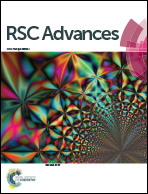Sputtering and sulfurization-combined synthesis of a transparent WS2 counter electrode and its application to dye-sensitized solar cells†
Abstract
In this work, continuous and large-area tungsten sulfide (WS2) films, deposited by radio frequency sputtering followed by a sulfurization process, were applied as a low-cost platinum (Pt)-free counter electrode (CE) for dye-sensitized solar cells (DSSCs). The composition and structure of WS2 films were confirmed using X-ray diffraction, field-emission scanning electron microscopy, Raman spectroscopy and X-ray photoemission spectroscopy techniques. The WS2 CE was phase pure and considerably transparent. The cyclic voltammetry, electrochemical impedance spectroscopy and Tafel curve showed that the WS2 CE possesses high electrocatalytic activity and fast reaction kinetics for the reduction of tri-iodide to iodide, which can be attributed to its inherent catalytic property. Finally, TiO2-based DSSC with an optimized WS2 CE (sputtered for 10 min) showed as high as 6.3% power conversion efficiency, which was comparable to the performance of DSSC with a Pt-based CE (6.64%). Our study demonstrated the feasibility to develop low-cost, transparent, catalytically active, stable and abundant metal chalcogenide catalysts by an RF sputtering method to replace Pt CE for photovoltaic application.


 Please wait while we load your content...
Please wait while we load your content...